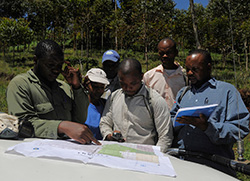Land governance and planning

Land governance concerns the rules, processes and structures through which decisions are made about access to land and its use, the manner in which those decisions are implemented and enforced, and the way in which competing interests in land are managed. Land governance therefore encompasses statutory, customary, religious and informal institutions. It includes state structures such as land agencies, courts and ministries and municipalities responsible for land, as well as informal land developers and traditional bodies. The concept of land governance covers the legal and policy framework for land, as well as traditional practices governing land transactions, inheritance and dispute resolution. In short, it is fundamentally about power and the political economy of land.
An integrated system for managing water and land, anchored in the genuine participation of stakeholders, is crucial for achieving the Sustainable Development Goals, including those related to reducing poverty and sharing prosperity.
Case study: the Near East

In the Near East, land and water shortages, land degradation, out-of-date land tenure systems and food insecurity are exacerbated by asymmetries in gender roles and power, imbalances in the political–military structures within and between countries, deficiencies in land and water management and control systems, and a continual rise in demand driven by high rates of population growth and urbanization. The dynamic, complex interplay of such forces governs the allocation of land and water, the actors who benefit from the availability of these resources and, ultimately, resource sustainability. The existing allocation arrangements of the region’s three major river basins – the Nile, the Euphrates-Tigris and the Jordan – are nascent sources of tension and potentially of conflict and violence over land and water. The political instability that characterizes the Near East intensifies scarcity, suppresses growth and engenders poverty, and it is likely to be exacerbated by climate change.
The Middle East is one of the most water-poor and water-stressed regions worldwide. Existing land-tenure systems are failing to address long-standing problems: growing numbers of smallholder farmers, landless households and marginalized groups such as women compete for shrinking natural resources, and pastoralists are losing control of their traditional grazing areas.

The use and management of, and access to, land and water are increasingly contentious. Governments and local actors often perceive these issues differently, and an immense effort is required to implement a participatory approach to decision-making that involves all local actors in an equitable and balanced way. A pressing need is the engagement and participation of women, girls and other marginalized groups in all aspects of water use and food production; they constitute the main agricultural labour force and are the most deprived stakeholders.
There remains an information gap on the nexus between gender and water and land resources in the Arab region. There is little systematic knowledge about the many means by which women and men manage water and land in the region. There is evidence, for example, that women in Egypt play significant roles in food production by controlling and managing water flows in fields and supervising workers during irrigation, but they rarely own the land they cultivate. Women everywhere in the Middle East evaluate water quantity and quality and prioritize water for drinking and health and sanitation purposes, but they rarely share equally in the benefits of their labour or in the ownership of the land and water resources they help manage.
